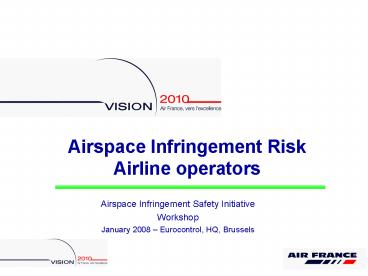Airspace Infringement Safety Initiative - PowerPoint PPT Presentation
1 / 13
Title:
Airspace Infringement Safety Initiative
Description:
From cruize to initial descent : class A controlled airspace ... Early descent Scenario. Aircraft cleared too soon to descent to final descent altitude ... – PowerPoint PPT presentation
Number of Views:64
Avg rating:3.0/5.0
Title: Airspace Infringement Safety Initiative
1
Airspace Infringement Risk Airline operators
- Airspace Infringement Safety Initiative
- Workshop
- January 2008 Eurocontrol, HQ, Brussels
2
Preventing Airspace Infringement Operators
Generic Accident Families
3
Preventing Airspace Infringement Risk Management
Perspective
4
Preventing Airspace Infringement Threat and
Error Management perspective
5
Preventing Airspace Infringement See and
Avoid Limits
6
Preventing Airspace Infringement See and
Avoid Limits
A320 and Glider FL80 Class G Airspace Feb
1999 - France
7
Preventing Airspace InfringementSee and Avoid
Limits
8
Preventing Airspace Infringement Class of
Airspace Crew Awareness Limits
- The Midair Collision Case (A320/Glider)
- Type of airspace successively crossed during A320
arrival - From cruize to initial descent class A
controlled airspace - Descending below FL195 class D controlled
airspace - At 15h38, 38 Nm from destination, passing FL115
class G uncontrolled airspace corresponding to
LF-R108E2 regulated zone (inactive at this time) - The mid air collision occurred at 15h40 at FL80
in this class G airspace. - Minutes after the collision class D controlled
airspace S/CTA Rhône 3 - Descending through 5700 ft class E controlled
airspace airport TMA 4 - At about 4900 ft class D, destination airport
TMA 3 - Then the A320 flew until landing in this class D
controlled airspace while entering successively
the TMA 1 then CTR of destination airport. - Difficult to be constantly aware of the type of
airspaces crossed while preparing for an approach
and watching outside in compliance with the see
and avoid rule ?
9
Preventing Airspace Infringement Some Incident,
Accident
- Infringement not only for G.Aviation
- Early descent Scenario
- Aircraft cleared too soon to descent to final
descent altitude - Visual approach scenario
- Leading to flight path conflicting with secondary
ruwnay circuit dedicated to GA - Crew not always aware of mixed IFR/VFR trafic
airspace - Scenic arrival and departure
- Table mountain in Cape town
- Training flight
- Airport or runway confusion
10
Preventing Airspace Infringement
One landing on wrong airport per year
worldwideTen to 100 landings per year on a wrong
runway
11
Preventing Airspace Infringement Some Type of
Threats for Airlines Operators
- Gliders
- Light VFR aircraft
- Weather balloons
- Hot air balloon
- Kites
- Para jumping
- Drone
12
Preventing Airspace Infringement Contribution of
Operators
- Contribution of airlines
- Better crew reporting (accuracy, relevancy)
- Better Information Sharing
- Departure and approach trajectory modification
- Lobbying airline pilot for influencing GA
association they may belong - Increasing crew awareness about mid air collision
risk on some airspace - Others
13
Preventing Airspace Infringement Contribution of
Operators
- THANK YOU !
14
Preventing Airspace Infringement Threat and
Error Management perspective
- Threat are situations external to the flight
deck, that must be managed by the cockpit crew
during normal, everyday flights. Such events
increase the operational complexity of flight and
pose a safety risk to the flight at some level. - Error are actions or inactions by the crew that
lead to deviations from organisational or flight
crew intentions or expectations. Errors in the
operational context tend to reduce the margin of
safety and increase the probability of accidents
or incidents































